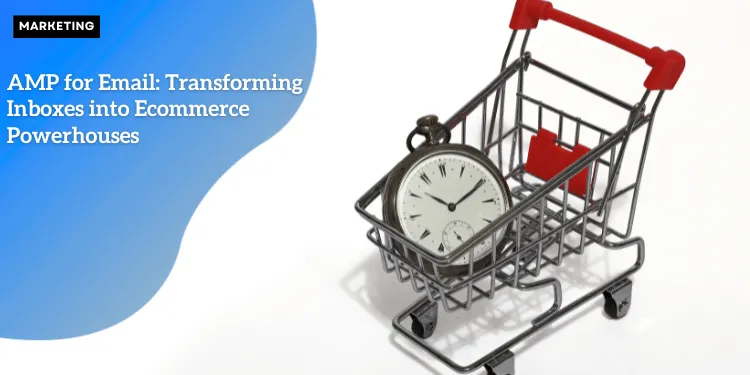AMP for Email: Transforming Inboxes into Ecommerce Powerhouses

Anúncios
Introduction: The Untapped Potential of AMP for Email in Ecommerce
In the fast-paced world of ecommerce, marketers are constantly looking for innovative ways to increase revenue and streamline the customer experience.
While much attention is often given to the latest social media trends, paid ads, and website optimization, one area that remains somewhat underutilized is email marketing.
Surprisingly, the key to unlocking email’s potential for higher conversion rates may lie in a technology that many have overlooked—AMP for Email.
AMP for Email, an extension of Google’s Accelerated Mobile Pages (AMP), offers ecommerce businesses the ability to deliver dynamic and interactive email experiences that feel more like browsing a website than reading an email.
Anúncios
Marketers who have implemented this technology have reported impressive results, including higher engagement rates, improved open rates, and increased sales.
Companies like Zaymo and Mailmodo, which specialize in interactive email solutions, have been at the forefront of utilizing AMP to revolutionize email marketing.
In this article, we will explore how AMP for Email works, its potential benefits for ecommerce marketers, and the challenges to consider before implementing it into your email marketing strategy.
Anúncios

What is AMP for Email?
AMP for Email is an extension of the Accelerated Mobile Pages (AMP) framework, originally developed by Google in 2015.
AMP was designed to speed up mobile web pages by simplifying their design and reducing load times, making browsing more efficient on smartphones.
AMP for Email takes this concept a step further by allowing marketers to create highly interactive and dynamic emails, providing users with an app-like experience directly within their inboxes.
This technology enables marketers to embed interactive elements such as product carousels, form submissions, and cart updates directly within the email itself, removing the need for recipients to click through to a website.
Essentially, AMP for Email allows recipients to shop, browse, and make purchases—all without leaving the email.
How AMP for Email Works
AMP for Email is built using a set of unique tags and HTML extensions that allow for dynamic content.
Unlike traditional HTML emails, which are static and limited in interactivity, AMP emails are able to feature elements that can change or respond to user actions, such as:
| Feature | Description |
|---|---|
| 📸 Product Carousels | Recipients can swipe through a product gallery directly in their inbox, allowing them to view multiple items effortlessly. |
| 🎨 Product Variants | Shoppers can select different sizes, colors, or configurations for a product directly in the email without leaving the inbox. |
| 🛒 Shopping Cart | Users can add items to their cart directly in the email and proceed to checkout seamlessly, making shopping easier. |
AMP emails can also be designed to update in real-time, such as displaying live inventory updates or personalized product recommendations based on user behavior or preferences.
However, not all inboxes support AMP for Email yet.
The technology is currently supported by major providers like Gmail, Yahoo Mail, FairEmail, and Mail.ru, but Apple Mail and several other email clients do not yet support AMP.
The Benefits of AMP for Email
For ecommerce marketers, the potential of AMP for Email lies in its ability to transform traditional emails into fully interactive shopping experiences.
Here are some of the primary benefits that AMP for Email can bring to your marketing efforts:
1. Increased Engagement and Interaction
AMP for Email provides users with the ability to engage directly within the email itself, which can result in higher levels of interaction.
Instead of just reading a promotional message or clicking a link to visit a product page, recipients can browse products, select sizes, and add items to their cart—all within the email.
This level of interactivity reduces friction in the shopping journey, which can lead to higher conversion rates.
When users can make purchases without navigating away from the email, the overall shopping experience becomes much smoother and more streamlined.
2. Improved Open Rates and Deliverability
Interactive content tends to be more engaging, and this can positively impact email open rates.
According to Jaina Mistry, Director of Brand and Content Marketing at Litmus, “Interactive emails using AMP for Email create more opportunities for the recipient to engage with your email.
So yes, it can have a positive impact on your deliverability by improving engagement.”
The increased engagement can also improve email deliverability.
When users interact with AMP emails, email providers are more likely to see these messages as valuable, which may result in better inbox placement and fewer emails being marked as spam.
3. Enhanced User Experience
By enabling customers to complete a purchase or interact with a product directly within the email, AMP for Email offers an app-like experience that feels modern and convenient.
For ecommerce businesses, this can differentiate them from competitors who still rely on basic, static email designs.
This user-centric approach encourages recipients to return to the inbox for future purchases, fostering customer loyalty.
Providing a seamless experience between the email and the shopping cart can also help reduce abandonment rates.
4. Time-Saving for Marketers
Instead of sending multiple follow-up emails and directing customers to various landing pages, AMP for Email allows ecommerce marketers to keep customers engaged and moving forward in the purchasing process within a single email.
With the interactive elements built into the email itself, customers can explore products, update carts, and complete purchases in one fell swoop, without needing to navigate away from the email.
Challenges of AMP for Email
While AMP for Email offers a range of benefits, there are still a few challenges and considerations that marketers must take into account before implementing this technology:
1. Limited Support Across Email Clients
One of the biggest challenges with AMP for Email is that it is not yet universally supported. While Gmail, Yahoo Mail, and a few other platforms support AMP, many major email clients, particularly Apple Mail, do not.
According to Brice Douglas, CEO and co-founder of Zaymo, AMP for Email currently works in only about one-third of all inboxes.
This limitation means that marketers must ensure they have a fallback strategy in place for users whose inboxes don’t support AMP.
Fortunately, tools like Zaymo and Mailmodo offer fallback options, allowing marketers to deliver a standard HTML or CSS-based email experience to users who can’t view the interactive AMP content.
2. Compatibility with Email Service Providers (ESPs)
Not all email service providers (ESPs) support AMP for Email. For marketers to take full advantage of AMP, they must work with an ESP that supports the creation and sending of AMP emails.
While there are several ESPs that support AMP, the list is still relatively limited—only around 30 providers offer the necessary tools for creating AMP-powered emails.
This means that businesses must do their due diligence when selecting an ESP to ensure it integrates seamlessly with their ecommerce platform and can send AMP emails.
3. Technical Complexity and Implementation
While creating AMP emails may seem like a straightforward process, it requires a solid understanding of the underlying AMP framework and email coding standards.
While tools like Zaymo and Mailmodo simplify the process, marketers still need to test and optimize their emails to ensure they work properly across different email clients and devices.
As with any new technology, implementing AMP for Email can require a learning curve and additional resources for testing and troubleshooting.
4. The AMP Ecosystem’s Inactivity
Another potential concern is the current inactivity within the AMP community.
At the time of writing, the AMP Slack community had not posted any significant updates since February 2022.
The lack of ongoing discussions and activity within the AMP ecosystem raises questions about the future trajectory of the technology.
While it is unlikely that AMP for Email will be discontinued, as Google continues to support it, a lack of community engagement could signal reduced interest in the framework.
How to Implement AMP for Email in Your Ecommerce Strategy
For ecommerce marketers who want to try AMP for Email, here are the key steps to get started:
- Research Interactive Email Tools: Look into tools like Zaymo and Mailmodo, which offer AMP for Email integration with popular ecommerce platforms.
- Ensure ESP Compatibility: Verify that your current ESP supports AMP-powered email creation. If not, consider switching to a provider that offers AMP capabilities.
- Register for AMP: To send AMP-powered emails, marketers must register with the AMP for Email program and follow the necessary guidelines.
- Test and Optimize: Before sending AMP emails to your entire list, conduct thorough testing to ensure that the emails perform well across different email clients and devices.
By following these steps, marketers can start leveraging AMP for Email to improve engagement, enhance user experience, and ultimately drive higher conversions.
Conclusion: The Future of Ecommerce Email Marketing with AMP
AMP for Email has the potential to revolutionize the way ecommerce businesses engage with customers via email.
By offering an interactive, app-like experience within the inbox, AMP allows marketers to simplify the purchasing process, increase engagement, and drive higher conversion rates.
However, while AMP for Email is a promising technology, it does come with some challenges, including limited support across email clients and the need for compatibility with specific ESPs.
Nonetheless, for businesses that are ready to embrace this technology, AMP for Email provides a powerful tool to stand out in crowded inboxes and deliver a seamless, high-quality shopping experience that drives results.
As the adoption of AMP for Email continues to grow and more email clients begin to support the technology, its impact on ecommerce email marketing will likely become even more significant.
By implementing AMP for Email today, ecommerce marketers can position themselves at the forefront of a new era of email marketing.
